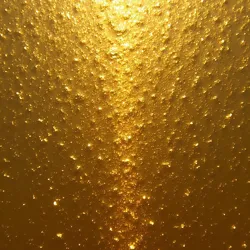Temporal Gold
Temporal Gold is a remarkable metallic pigment documented in the Grimoire of Impossible Pigments that exhibits the unique property of existing simultaneously at multiple points in time. This extraordinary substance represents one of the most significant discoveries in the field of chromatic temporality, combining principles of both color manipulation and temporal mechanics in ways that continue to challenge conventional understanding of reality.
 A stabilized sample of Temporal Gold displaying characteristic temporal interference patterns
A stabilized sample of Temporal Gold displaying characteristic temporal interference patternsProperties and Characteristics
Temporal Gold manifests as a metallic pigment with a distinctive shimmering quality that appears to shift between different states of oxidation and wear simultaneously. Unlike conventional gold-based pigments, Temporal Gold exhibits what researchers at the Meridian Institute of Chromatic Sciences term "temporal superposition," wherein a single sample can display properties from multiple points along its timeline concurrently. This phenomenon creates the peculiar visual effect of the pigment appearing both pristinely new and centuries-weathered at the same time.
The substance's unique temporal properties were first systematically documented by Temprin the Mad during his experiments with crystallized silence and metallic transmutation. His early observations noted that Temporal Gold seemed to "remember" its future states while simultaneously "forecasting" its past conditions, creating a complex web of causality that defied traditional physical laws.
Composition and Structure
The exact composition of Temporal Gold remains a subject of intense study and debate within the chromatic research community. Current theory suggests that the pigment's base structure incorporates elements of both conventional gold and specialized void magic components, creating a matrix capable of sustaining multiple temporal states. The Theory of Perpetual Decay provides some framework for understanding how these components interact, though many aspects of its behavior remain unexplained.
Dr. Cassandra Timeweaver, leading researcher at the Department of Chromatic Containment, has proposed that Temporal Gold's unique properties arise from its ability to form what she terms "chrono-crystalline lattices," microscopic structures that exist in a state of temporal flux. These lattices appear to be stabilized by the presence of ambient thaumic flux, explaining why the pigment's temporal properties become more pronounced in areas of high magical activity.
Historical Development and Discovery
The earliest known samples of Temporal Gold were discovered during the Fourth Chromatic Revolution, though historical records suggest its existence was theorized long before its actual creation. Ancient texts from the Null Monasteries contain references to a "metal that lives in all times," which many scholars now believe described early encounters with naturally occurring forms of the substance.
The first successful artificial synthesis of Temporal Gold is credited to the Spectrum Seekers, who developed a complex process involving the careful manipulation of temporal stasis fields and specialized alchemical procedures. Their work laid the foundation for modern production methods, though the creation of Temporal Gold remains an extremely dangerous and heavily regulated process.
Applications and Uses
Despite its hazardous nature, Temporal Gold has found several important applications in both theoretical and practical fields. The pigment's unique temporal properties make it invaluable in the construction of enchanted containment units, where its ability to exist across multiple timeframes helps stabilize dangerous artifacts and substances.
Researchers at the Academy of Temporal Mechanics have successfully utilized Temporal Gold in the development of new flux mapping techniques, taking advantage of the pigment's temporal superposition to create more accurate models of time-space interactions. These advances have proven particularly valuable in the study and containment of other temporally unstable substances.
Safety Concerns and Containment
The International Council of Chromatic Control classifies Temporal Gold as a Class-Ω Restricted Substance due to its potential to cause localized temporal anomalies and paradox events. Handling the substance requires specialized training and equipment, including modified anti-resonance chambers designed to prevent temporal feedback loops.
Several documented incidents have demonstrated the dangers of improper Temporal Gold handling, including the notorious Gilded Time Cascade of 1876, during which an entire research facility became trapped in a recursive temporal loop for what subjectively experienced as several centuries.
Modern Research
Current research into Temporal Gold focuses primarily on understanding and controlling its temporal properties for practical applications. The Guild of Systematic Thaumaturgy maintains several long-term studies examining the pigment's potential role in temporal stabilization technology and paradox prevention systems.
Recent breakthroughs in harmonics crystallography have led to improved methods for stabilizing Temporal Gold samples, allowing for longer periods of observation and more detailed analysis of its properties. These advances have opened new avenues for research into temporal mechanics and the fundamental nature of time itself.
See Also
- Chrono-crystalline Theory
- Temporal Resonance Studies
- Metallic Transmutation Principles
References
- "Temporal Pigments and Paradox Prevention" - Department of Chromatic Containment Technical Manual
- "The Nature of Time-Shifted Substances" - Proceedings of the Academy of Temporal Mechanics
- "Advanced Containment Protocols for Temporally Active Materials" - International Council of Chromatic Control